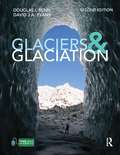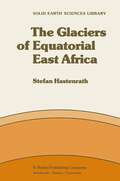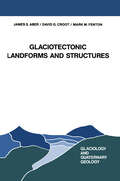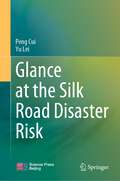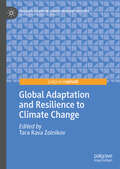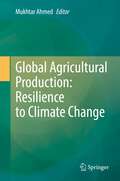- Table View
- List View
Glaciers and Glaciation, 2nd edition
by Douglas Benn David J EvansGlaciers and Glaciation is the classic textbook for all students of glaciation. Stimulating and accessible, it has established a reputation as a comprehensive and essential resource.In this new edition, the text, references and illustrations have been thoroughly updated to give today's reader an up-to-the minute overview of the nature, origin and behaviour of glaciers and the geological and geomorphological evidence for their past history on earth.The first part of the book investigates the processes involved in forming glacier ice, the nature of glacier-climate relationships, the mechanisms of glacier flow and the interactions of glaciers with other natural systems such as rivers, lakes and oceans.In the second part, the emphasis moves to landforms and sediment, the interpretation of the earth's glacial legacy and the reconstruction of glacial depositional environments and palaeoglaciology.
Glaciers and Glaciation, 2nd edition
by Douglas Benn David J EvansGlaciers and Glaciation is the classic textbook for all students of glaciation. Stimulating and accessible, it has established a reputation as a comprehensive and essential resource.In this new edition, the text, references and illustrations have been thoroughly updated to give today's reader an up-to-the minute overview of the nature, origin and behaviour of glaciers and the geological and geomorphological evidence for their past history on earth.The first part of the book investigates the processes involved in forming glacier ice, the nature of glacier-climate relationships, the mechanisms of glacier flow and the interactions of glaciers with other natural systems such as rivers, lakes and oceans.In the second part, the emphasis moves to landforms and sediment, the interpretation of the earth's glacial legacy and the reconstruction of glacial depositional environments and palaeoglaciology.
Glaciers and Ice Sheets in the Climate System: The Karthaus Summer School Lecture Notes (Springer Textbooks in Earth Sciences, Geography and Environment)
by Andrew Fowler Felix NgOur realisation of how profoundly glaciers and ice sheets respond to climate change and impact sea level and the environment has propelled their study to the forefront of Earth system science. Aspects of this multidisciplinary endeavour now constitute major areas of research. This book is named after the international summer school held annually in the beautiful alpine village of Karthaus, Northern Italy, and consists of twenty chapters based on lectures from the school. They cover theory, methods, and observations, and introduce readers to essential glaciological topics such as ice-flow dynamics, polar meteorology, mass balance, ice-core analysis, paleoclimatology, remote sensing and geophysical methods, glacial isostatic adjustment, modern and past glacial fluctuations, and ice sheet reconstruction. The chapters were written by thirty-four contributing authors who are leading international authorities in their fields. The book can be used as a graduate-level textbook for a university course, and as a valuable reference guide for practising glaciologists and climate scientists.
Glaciers, Nature, Water, and Local Community in Mount Kenya (International Perspectives in Geography #17)
by Kazuharu Mizuno Yuya OtaniThis book describes the challenges for the natural environments and local communities in the future. Among the high mountains of Africa, only Kilimanjaro, Mount Kenya, and the Rwenzori Mountains are still capped with glaciers. The retreating rate of these glaciers has accelerated, and they are expected to disappear in the near future. In the area around Mount Kenya, the precipitation is generally low, such that rainfall cannot stably supply water for farmlands and daily life. It has been revealed that the glacial meltwater has produced springs at the foot of the mountain. It is therefore important to characterize the condition of water sources near Mount Kenya for use by local people. This book discusses the relationships between the actual state of the climate and glacier shrinkage around Mount Kenya, the surrounding vegetation, soil, and water environments, and the lives of the foothill region inhabitants confronting the glacier shrinkage. This book is valuable in the contemporary age, when the assurance of a sustainable relationship between nature and mankind is critical.
Glaciers of Georgia (Geography of the Physical Environment)
by Levan TielidzeThis book gives the most detailed and comprehensive insights into the morphology, morphometry and dynamics of glaciers in the Georgian Caucasus region up to date. It examines the variability of valley glaciers after the Little Ice Age maximum and identifies glacial dynamics during historical periods. The reconstruction of glaciation in the Late Pleistocene and Holocene was conducted based on long lasting detailed glacial-geomorphological observations by the author. It further analyses moraine structures, river terraces, geodynamics of the relief, and snow and firn line locations derived from field surveys in most glacier basins in the southern and northern slopes of the Georgian Caucasus. A whole set of methodological approaches was applied including remote sensing and GIS, glacio-geomorphological, cartographical, aerial image processing and petrographic methods, unveiling accurate information about glaciers difficult to access, e.g. in the Abkhazeti and Tskhinvali regions. The book provides a full database of Georgia’s modern glaciation and displays a set of compiled maps of the distribution of the Late Pleistocene glaciation of the Georgian Caucasus.
The Glaciers of Iceland: A Historical, Cultural and Scientific Overview (Atlantis Advances in Quaternary Science #2)
by Helgi Björnsson Julian Meldon D'ArcyThis book is the first comprehensive overview and evaluation of the origins, history and current size and condition of all of Iceland's major glaciers (including Vatnajökull, the largest in Europe) at the beginning of the twenty-first century. It is not only illustrated with many beautiful photographs and graphs of recent statistics and scientific data, but is also a collection of historical writings and drawings from annals, sagas, folk tales, diaries, reports, stories and poems, as it presents a unique approach to the study of glaciers on an island in the North Atlantic. Balancing and comparing the world of man with the world of nature, the perceptions of art and culture with the systematic and pragmatic analyses of science, The Glaciers of Iceland present a wide spectrum of readers with a new and stimulating view of the origins, development and possible future of these massive natural phenomena, as well as the study and role of glaciology, within specific time lines and geographical locations. Icelandic glaciers the author argues could prove essential for understanding the current unsettling progress of global warming. The glaciers of Iceland, therefore, aims at presenting to a wide readership an original, historical, cultural and scientific overview of these geophysical features in Iceland while also suggesting increasingly important lessons and models for man's future interaction with the world's glaciers as a whole.
Glaciers of the Karakoram Himalaya: Glacial Environments, Processes, Hazards and Resources (Advances in Asian Human-Environmental Research #Vol. 4)
by Kenneth HewittThe Karakoram contains the greatest concentration of glaciers and most of the largest ice masses outside high latitudes. They comprise major stores and sources of fresh water in an otherwise extreme, continental, dry region. As many as 200 million people living downstream, in the valleys of the Indus and Yarkand Rivers, depend on melt waters from snow and ice. They are at risk from climate-change impacts on glaciers and water supply, and from hazards such as glacial lake outburst floods. Useful research initiatives go back to the nineteenth century, but coverage has generally been limited geographically and has not been continuous over time. It is almost 80 years since a monograph was devoted to the Karakoram glaciers. The book presents a comprehensive overview, including statistics for the ice cover, glacier mass balance and dynamics, glacierized landscapes, rock glaciers, water resources and environmental hazards. Published glaciological and related research is surveyed along with expedition reports and archival materials in several languages. The expanding potential of satellite coverage is exploited, but conditions and processes reported from field investigations are the main focus. Previously unpublished observations by the author are presented, based on some 45 years of work in the region. Broad understanding of the glacial environment is used to address emerging concerns about the High Asian cryosphere and the fate of its glaciers. These are discussed in relation to the pressing issues of water supply, environmental risk and sustainability. Questions of what is not known help identify much needed monitoring and research. The book is of interest to researchers, professionals, and those studying glaciers, mountain environments, water resources and environmental hazards. The topics discussed should be of concern for anyone involved in regional development and global change in South and Inner Asia.
Glaciokarsts (Springer Geography)
by Márton Veress Tamás Telbisz Gábor Tóth Dénes Lóczy Dmitry A. Ruban Jaroslav M. GutakThis book discusses the theoretical and practical issues of glaciokarsts. After a research history, a general description of glaciokarsts is provided. Thereafter, the glacial erosion on karst, the karstic features of glaciokarsts, the development of these features, the karstic zones of glaciokarsts, surface development of glaciokarsts, case studies on glaciokarsts and an overview of the glaciokarsts of the Earth are presented.
Glaciology and Glacial Geomorphology
by Wilfried HaggThis textbook covers all important aspects of mountain glaciers, from their formation and their importance as water reservoirs to the threat posed by current global warming. Glaciers themselves can also pose a threat to humans and represent a natural hazard in populated mountain areas in the form of ice avalanches and glacial lake outbursts. In addition, however, they are also important landscape formers and have helped to shape large parts of the present-day relief of the Earth, which is one of the classic fields of work of geomorphology and geology.In the individual chapters, the current state of research is presented in a comprehensible manner and illustrated with concise examples, photos and graphics.The book offers a compact introduction for all students of geosciences, curious mountaineers and laymen interested in nature.
Glaciotectonic Landforms and Structures (Glaciology and Quaternary Geology #5)
by J. S. Aber David G. Croot Mark M. FentonGlance at the Silk Road Disaster Risk
by Peng Cui Yu LeiThis book vividly shows the fostering environment, activity characteristics, distribution pattern, economic losses, casualties, disaster risks and management of earthquakes, mass movement, drought, floods, and marine disasters in the Silk Road region. It develops a multi-scale and multi-disaster risk assessment method to better assess and understand the Silk Road disaster risk. A multi-level collaborative risk management model has been proposed for transboundary disasters, and it also shares case studies on major disaster risk management. The book makes a major step forward to increase the understanding of the disaster risk of the Silk Road region. It presents a holistic understanding of the natural hazards and their induced disaster risks and is a valuable read for scholars, stakeholders and practitioners in the DRR community.
Glass Chemistry
by Werner VogelGlass Chemistry is concerned with the relation of chemical composition, structure and properties of various glasses. The book has been translated from the third German edition, which serves as a textbook for university students in materials sciences and a reference book for scientists and engineers in glass science and production. The central themes of the book are the chemistry and physics of glass. Detailed knowledge of the compositional and structural facts is the basis for the systematic development of new glasses as construction and optical materials.Glass Chemistry is an interdisciplinary book on the borderlines between chemistry, physics, mineralogy and even biology and medicine. The book represents a well balanced treatment for students, scientists and engineers.
Glasses and Grains: Poincaré Seminar 2009 (Progress in Mathematical Physics #61)
by Bertrand Duplantier Thomas C. Halsey Vincent RivasseauThis tenth volume in the Poincaré Seminar Series describes recent developments at one of the most challenging frontiers in statistical physics - the deeply related fields of glassy dynamics, especially near the glass transition, and of the statics and dynamics of granular systems. These fields are marked by a vigorous interchange between experiment, theory, and numerical studies, all of which are well represented by the leading experts who have contributed articles to this volume. These articles are also highly pedagogical, as befits their origin in lectures to a broad scientific audience. Highlights include a Galilean dialogue on the mean field and competing theories of the glass transition, a wide-ranging survey of colloidal glasses, and experimental as well as theoretical treatments of the relatively new field of dense granular flows. This book should be of broad general interest to both physicists and mathematicians.
Gletscher im Wandel: 125 Jahre Gletschermessdienst des Alpenvereins
by Andrea Fischer Gernot Patzelt Martin Achrainer Günther Groß Gerhard Karl Lieb Andreas Kellerer-Pirklbauer Gebhard BendlerDieses Buch beschreibt den Umfang und das Ergebnis der Gletschermessungen seit der kleinen Eiszeit und verdeutlicht so den heutigen Stellenwert der in den Ostalpen gemessenen Daten für die Klimaforschung. Die Autor/innen stellen frühe Forschungsleistungen des Alpenvereins, wie den Nachweis der Existenz der Eiszeiten oder die Entdeckung des Fließgesetzes für Gletschereis vor. Spannende Blicke ins Archiv zeigen exemplarisch die Mechanismen und Auswirkungen des Gletscherrückganges. Besonders detailliert ist Österreichs größter Gletscher, die Pasterze im Glocknergebiet, beschrieben.So entsteht für interessierte Laien ein Bild der Beziehung zwischen Gletscher und Klima mit vielen geomorphologischen Details. Studierende und Absolvent/innen der Geowissenschaften finden wissenschaftshistorisch relevante Details und regionale Fakten zum Klimawandel und dessen Erforschung.
Gletscherkunde und Glazialgeomorphologie
by Wilfried HaggDieses Lehrbuch behandelt alle wichtigen Aspekte zu Gebirgsgletschern, von ihrer Entstehung über ihre Bedeutung als Wasserspeicher bis hin zu ihrer Bedrohung durch die aktuelle Klimaerwärmung. Gletscher können auch selbst zur Bedrohung für den Menschen werden und in Form von Eislawinen und Gletscherseeausbrüchen eine Naturgefahr in besiedelten Gebirgsräumen darstellen. Daneben sind sie aber auch wichtige Landschaftsformer und haben große Teile des heutigen Erdreliefs mitgestaltet, was zu den klassischen Arbeitsfeldern von Geomorphologie und Geologie gehört. In den einzelnen Kapiteln wird der aktuelle Forschungsstand nachvollziehbar präsentiert und anhand prägnanter Beispiele, Fotos und Grafiken veranschaulicht. Aufgrund der Dominanz des Englischen als Wissenschaftssprache werden deutsche Fachbegriffe dort, wo es sinnvoll und nötig ist, der englischen Terminologie gegenübergestellt.Das Buch bietet eine kompakte Einführung für alle Studierenden der Geowissenschaften, neugierige Bergsteiger und naturinteressierte Laien. Ein Glossar erklärt über 250 Fachbegriffe von A wie Ablation bis Z wie Zungenbecken. Zusätzliche Fragen zum Selbsttest per App: Laden Sie die Springer Nature Flashcards-App kostenlos herunter und nutzen Sie exklusives Zusatzmaterial, um Ihr Wissen über Rundhöcker, Drumlins und Moränen zu prüfen.
Global Action for Biodiversity: An International Framework for Implementing the Convention on Biological Diversity
by Timothy SwansonAt the Rio Earth Summit in 1992, the nations of the world adopted the convention on Biological Diversity. Since then, over 160 countries have ratified the Convention, three Conferences of the Parties have taken place and a permanent secretariat has been established. Despite this, there remains a lot of uncertainty and even more controversy about what the Convention was intended to accomplish and how it was to do so. This book, published in association with the IUCN - The World Conservation Union, sets out to answer some of these questions by recounting the history of the movements leading up to the Convention, but especially by analysing the forces giving rise to the problem. It provides a specific set of policy prescriptions intended to facilitate the development of institutions and obligations within the international community which will give real effect to the aspirations of the Convention, and the ensure that it has some real effect at ground level. The author begins with an overview of the issues and then develops the basic nature of the problems within a bio-economic framework. He highlights the gaps in the Convention which remain to be filled, offers detailed explanations of the concepts involved and describes the nature of the solutions required. Thus he sets out a detailed plan for global action in support of an effective international convention for the conservation of biological diversity. The book is an excellent introduction to a very topical debate, and a valuable reference point for conservationists, policy makers and students of development studies, environmental studies, environmental policy and conservation biology.
Global Action for Biodiversity: An International Framework for Implementing the Convention on Biological Diversity
by Timothy SwansonAt the Rio Earth Summit in 1992, the nations of the world adopted the convention on Biological Diversity. Since then, over 160 countries have ratified the Convention, three Conferences of the Parties have taken place and a permanent secretariat has been established. Despite this, there remains a lot of uncertainty and even more controversy about what the Convention was intended to accomplish and how it was to do so. This book, published in association with the IUCN - The World Conservation Union, sets out to answer some of these questions by recounting the history of the movements leading up to the Convention, but especially by analysing the forces giving rise to the problem. It provides a specific set of policy prescriptions intended to facilitate the development of institutions and obligations within the international community which will give real effect to the aspirations of the Convention, and the ensure that it has some real effect at ground level. The author begins with an overview of the issues and then develops the basic nature of the problems within a bio-economic framework. He highlights the gaps in the Convention which remain to be filled, offers detailed explanations of the concepts involved and describes the nature of the solutions required. Thus he sets out a detailed plan for global action in support of an effective international convention for the conservation of biological diversity. The book is an excellent introduction to a very topical debate, and a valuable reference point for conservationists, policy makers and students of development studies, environmental studies, environmental policy and conservation biology.
Global Adaptation and Resilience to Climate Change (Palgrave Studies in Climate Resilient Societies)
by Tara Rava ZolnikovThis book explores the link between climate change and resiliency on each continent of the world. It reviews how climate change affects populations, not only through environmental exposures and health outcomes, but how people live their lives. Zolnikov brings together a set of experts to offer a novel perspective on understanding climate change vulnerability alongside adaption measures being implemented. Each chapter includes an overview on how climate change will affect that continent alongside current adaptation, mitigation, and policies that seek to improve population outcomes. As a whole, the book explores why a “one size fits all” approach to promote climate change resiliency does not work; however, a global perspective can facilitate people learning from one another and facing climate change together.
Global Agricultural Production: Resilience to Climate Change
by Mukhtar AhmedThis book covers all aspects related to climate change and agriculture. The book discusses Global Climate Models (GCMs), Coupled Model Intercomparison Project (CMIP) and application of strategic management tool that includes RCP (Representative concentration Pathway), SSP (Shared Socio-economic Pathways) and SPA (Shared climate Policy Assumptions). The book provides information on how climate change, agricultural productivity and food security are interlinked. The impacts of climate change on food security are studied through different climatic drivers e.g., ENSO (El Niño–Southern Oscillation) and SOI (Southern Oscillation Index). These drivers are responsible for the climatic extreme events hence early prediction of these drivers could help to design appropriate adaptive measures for the agriculture sector and could be considered as early warning tools for risk management. Similarly, climate change and process-based soil modeling as well as the role of soil microbes and climate smart agriculture are discussed in this book. Climate change impacts on legume crop production and adaptation strategies are presented, with details about cereal crop modeling, perspectives of Camelina sativa as well as low input biofuel and oilseed crop, greenhouse gases (GHGs) emissions and mitigation strategies.
Global Analysis in Mathematical Physics: Geometric and Stochastic Methods (Applied Mathematical Sciences #122)
by Yuri GliklikhThe first edition of this book entitled Analysis on Riemannian Manifolds and Some Problems of Mathematical Physics was published by Voronezh Univer sity Press in 1989. For its English edition, the book has been substantially revised and expanded. In particular, new material has been added to Sections 19 and 20. I am grateful to Viktor L. Ginzburg for his hard work on the transla tion and for writing Appendix F, and to Tomasz Zastawniak for his numerous suggestions. My special thanks go to the referee for his valuable remarks on the theory of stochastic processes. Finally, I would like to acknowledge the support of the AMS fSU Aid Fund and the International Science Foundation (Grant NZBOOO), which made possible my work on some of the new results included in the English edition of the book. Voronezh, Russia Yuri Gliklikh September, 1995 Preface to the Russian Edition The present book is apparently the first in monographic literature in which a common treatment is given to three areas of global analysis previously consid ered quite distant from each other, namely, differential geometry and classical mechanics, stochastic differential geometry and statistical and quantum me chanics, and infinite-dimensional differential geometry of groups of diffeomor phisms and hydrodynamics. The unification of these topics under the cover of one book appears, however, quite natural, since the exposition is based on a geometrically invariant form of the Newton equation and its analogs taken as a fundamental law of motion.
Global Analysis of Minimal Surfaces (Grundlehren der mathematischen Wissenschaften #341)
by Ulrich Dierkes Stefan Hildebrandt Anthony TrombaMany properties of minimal surfaces are of a global nature, and this is already true for the results treated in the first two volumes of the treatise. Part I of the present book can be viewed as an extension of these results. For instance, the first two chapters deal with existence, regularity and uniqueness theorems for minimal surfaces with partially free boundaries. Here one of the main features is the possibility of "edge-crawling" along free parts of the boundary. The third chapter deals with a priori estimates for minimal surfaces in higher dimensions and for minimizers of singular integrals related to the area functional. In particular, far reaching Bernstein theorems are derived. The second part of the book contains what one might justly call a "global theory of minimal surfaces" as envisioned by Smale. First, the Douglas problem is treated anew by using Teichmüller theory. Secondly, various index theorems for minimal theorems are derived, and their consequences for the space of solutions to Plateau´s problem are discussed. Finally, a topological approach to minimal surfaces via Fredholm vector fields in the spirit of Smale is presented.
